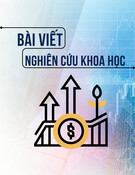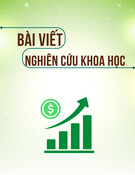
73
Journal of Development and Integration, No. 79 (2024)
* Corresponding author. Email: trangka.buh@gmail.com
https://doi.org/10.61602/jdi.2024.79.09
Received: 23-Jun-24; Revised: 30-Jul-24; Accepted: 09-Aug-24; Online: 01-Nov-24
ISSN (print): 1859-428X, ISSN (online): 2815-6234
K E Y W O R D S A B S T R A C T
Decision to use,
Factors affecting,
Ho Chi Minh City,
Mobile Banking,
University students.
The article studies the factors influencing the decision to use Mobile Banking among
university students in Ho Chi Minh City. Through a questionnaire administered to 294
students and utilizing the TAM model as a framework, the authors proposed six factors
and constructed a scale comprising 27 observational variables to assess their impact.
Throughout various stages including data processing, statistical analysis, scale reliability
testing, exploratory factor analysis, and linear regression, the research findings indicate
that all six expected factors significantly influence the decision to use Mobile Banking.
The impact of these factors decreases in the following order: perceived usefulness,
perceived ease of use, social influence, transaction costs, perceived risks and lastly
brand image. While most factors have a positive impact, perceived risk is the only factor
negatively affecting students’ decision to use Mobile Banking. Moreover, the decision to
use Mobile Banking shows no significant differences across gender, place of birth, year
of study, major and income. Finally, the author proposes practical implications for bank
management to enhance customer attraction and offers suggestions for future research
directions.
Nguyen Thi Thu Trang*, Phan Vu Duy Khang
Ho Chi Minh City University of Banking, Vietnam
Factors affecting the decision on using mobile banking of
university students: An empirical study in Ho Chi Minh City
1. Overview of Mobile Banking
1.1. Definition
In this modern days, consumers can install various
applications on their smartphones to meet different
needs. According to Hanafizadeh et al. (2014), the
banking sector has introduced numerous electronic
banking channels to supply diverse requirements
from customers and a recent addition to these
channels is Mobile Banking - which can offer a wide
range of financial services to consumers through
communication technologies.
Wessels and Drennan (2010) argue that Mobile
Banking represents a new dimension of electronic
banking, distinct from traditional telephone banking
services that offer limited functionalities, it serves
as a versatile platform for automated banking and
various financial services.
Ngo Duc Chien (2022) defined “Mobile banking is
a service offered by banks or other financial institutions
that enables their customers to conduct financial
No. 79 (2024) 73-84 I jdi.uef.edu.vn

74 Journal of Development and Integration, No. 79 (2024)
transactions remotely using mobile devices such as
smartphones and tablets. Unlike internet banking, it
involves the use of software, typically referred to
as an app, provided by financial institutions for this
purpose. Mobile banking is usually available 24/7.”
In summary, in this study, Mobile Banking can be
understood as a banking service performed on mobile
devices (smartphones or tablets) with an internet
connection, enabling customers to conduct a wide
range of transactions, fulfilling many customers’
needs without the need to visit the bank in person,
offering convenience and accessibility anytime,
anywhere.
1.2. Benefits of using Mobile Banking
According to Tran Huu Ai and Cao Hung Tan
(2020), Mobile Banking has significantly changed
the operations of banks, contributing to cost
reduction and increased efficiency for customers.
The essence of Mobile Banking lies in conducting
transactions through portable devices. Mobile
banking enables users to perform diverse financial
transactions anywhere and anytime, allowing 24/7
financial services, therefore customers can enjoy a
wide range of services, including checking balances,
transferring funds, paying bills, making purchases
through e-wallets, and engaging in online shopping
(Tran Huu Ai & Cao Hung Tan, 2020).
Therefore, using Mobile Banking helps customers
save time and transportation costs, especially
when there is a considerable geographical distance
between the bank and the customer. Compared to
the traditional approach of traveling to the bank
branch, waiting in line for transaction sessions or
searching for the nearest ATM for basic financial
needs, customers can now fulfill these requirements
anytime they want with just a few taps on their
portable devices.
On the other hand, for banks, Mobile Banking
significantly reduces overhead costs and staff
expenses - conducting transactions online shortens
processing times, standardizes procedures, and
enhances efficiency in document retrieval and
Figure 1. Research model
Nguyen Thi Thu Trang et al.

75
Journal of Development and Integration, No. 79 (2024)
processing. Consequently, it boosts operational
productivity and the bank’s revenue (Ngo Duc
Chien, 2022).
Furthermore, the data storage feature of Mobile
Banking ensures that customers can securely access
their transaction history and account information
conveniently. This not only deducts paperwork needs
but also improves transparency and accountability in
financial transactions. Also, by allowing customers
to track their savings and loan accounts in real-time,
Mobile Banking allows them to make informed
financial decisions and manage their finances more
effectively.
At the moment, most banks have already
deployed and developed Mobile Banking services.
For example, Vietcombank offers the VCB Digibank,
Standard Chartered with SC Mobile, VietinBank ưith
VietinBank iPay, Sacombank provides Sacombank
Pay,…
2. Research model
Based on theoretical foundations from theories
TRA, TPB, and notably TAM, the author decides to
utilize three factors: perceived usefulness, perceived
ease of use, and social influence to examine their
impact on the decision to use Mobile Banking among
students in HCMC. Additionally, drawing from
the findings of literature reviews of experimental
studies, the author takes in three additional factors
- transaction costs, brand image, and perceived risk
- into the research model to explore new dimensions
of the psychological and behavioral intentions of
present-day students. Therefore, the research model
is proposed as in Figure 1.
2. Relative empirical studies and research
hypothesis and scale construction
2.1. Foreign studies
Mamun et al. (2023) examined the factors affecting
Mobile Banking adoption in Bangladesh through the
evaluation of 630 people from January-June/2021.
Data were processed using Kaiser-Meyer-Olkin
(KMO) and Bartlett’s tests, reliability tests and EFA.
The study confirms that convenience, ease of use,
cost and comparative advantage positively affect the
decision to use Mobile Banking in Bangladesh, while
risk is a factor that has an opposite impact.
Kwateng et al. (2020) examined the factors that
influence customers’ acceptance and subsequent
use of Mobile Banking services in Ghana using the
Unified Theory of Acceptance and Use of Technology
(UTAUT2) model. The study sampled 300 Mobile
Banking service users in Ghana, and the results
showed that habits, values and beliefs are the main
factors influencing the adoption of Mobile Banking
in Ghana.
In a study by Makanyeza (2017), an examination
was carried out regarding the factors influencing the
adoption of Mobile Banking services in Zimbabwe.
The survey involved 232 customers across five banks
in Chinhoyi city. The research findings revealed that
perceived usefulness, effectiveness, social influence,
relative advantage, and compatibility demonstrated a
positive influence, whereas perceived risk exhibited
a negative impact on customers’ inclination to use
Mobile Banking services.
In a study by Sitorus et al. (2019), researchers
delved into the adoption behavior of mobile banking
Hypothesis Description Expected relationship
H1
Perceived usefulness positively influences the decision to use Mobile
Banking among university students in HCMC +
H2
Perceived ease of use positively influences the decision to use Mobile
Banking among university students in HCMC +
H3
Perceived risk negatively influences the decision to use Mobile
Banking among university students in HCMC -
H4
Social influence positively influences the decision to use Mobile
Banking among university students in HCMC +
H5
Reasonable transaction costs positively influence the decision to use
Mobile Banking among university students in HCMC +
H6
Brand image positively influences the decision to use Mobile Banking
among university students in HCMC +
Table 1. Summary of hypotheses
Nguyen Thi Thu Trang et al.

76 Journal of Development and Integration, No. 79 (2024)
No. Features Variable
code Source
1. Perceived usefulness PU
Riquelme and Rios (2010), Mamun
et al. (2023), Jeong and Yoon
(2013), Sakala and Phiri (2019)
1 Mobile Banking helps me deal with financial needs flexibly PU1
2Mobile Banking saves me time and transportation costs PU2
3 I have accessed more banking services thanks to Mobile Banking PU3
4Mobile Banking helps me manage my finances efficiently PU4
2. Perceived ease of use PEU
Ngo Duc Chien (2022), Sitorus
et al. (2019), Riquelme and Rios
(2010), Ha Nam Khanh Giao (2022)
5 I can quickly install Mobile Banking on my device PEU1
6 I find it easy to learn how to use Mobile Banking PEU2
7The use of Mobile Banking are simple to perform PEU3
8 I can proficiently use Mobile Banking PEU4
3. Perceived risks PR
Luo, Li, Zhang, and Shim (2010),
Alalwan et al. (2016), Thusi and
Maduku (2020), Vo Thi Phuong Lan
and Nguyen Thanh Giang (2021),
and Mamun et al. (2023)
9I worry that my personal information may be leaked when using Mobile Banking PR1
10 I fear that if I lose my phone with Mobile Banking, I might lose my money as well PR2
11 I am concerned about losing money in case of errors during transactions through
Mobile Banking PR3
12 When using Mobile Banking, I fear the possibility of my account being stolen by
hackers/thieves PR4
4. Social influence SI
Makanyeza (2017), Ngo Duc Chien
(2022), and Sitorus et al. (2019)
13 I am encouraged by my family/friends/teachers/… to use Mobile Banking SI1
14 I use Mobile Banking because of recommendations from my family/friends/teachers/… SI2
15 I feel confident using Mobile Banking when I see everyone around me using it SI3
5. Transaction costs TC
Awad and Dessouki (2017), Ngo
Duc Chien (2022), and Jeong and
Yoon (2013)
16 Using Mobile Banking helps me save more costs compared to transactions
at the counter TC1
17 I am satisfied with the fees associated with Mobile Banking because I receive
corresponding benefits TC2
18 I am well aware of the fees for using Mobile Banking TC3
19 The fees for Mobile Banking are reasonable TC4
6. Brand image BI
Ngo Duc Chien (2022), Vo Thi
Phuong Lan and Nguyen Thanh
Giang (2021)
20 I use Mobile Banking because it is a product of a reputable bank BI1
21 I am satisfied with the quality of the bank’s services BI2
22 I am attracted by the favorable policies of the bank BI3
23 I receive decent support when transaction issues arise BI4
7. Student’s decision SD
Ngo Duc Chien (2022), Xiao et
al. (2017), Lambert et al. (2019),
Makanyeza (2017)
24 I feel that Mobile Banking is an essential application SD1
25 I will continue to use Mobile Banking services SD2
26 I intend to explore more features in the future SD3
27 I will recommend people around me to use Mobile Banking SD4
Table 2. Summary of scale
Nguyen Thi Thu Trang et al.

77
Journal of Development and Integration, No. 79 (2024)
in Indonesia. They utilized partial least squares
structural equation modeling to test a proposed
model, drawing data from 319 respondents. The
results supported all hypotheses, indicating that
individuals’ intention to persist in using mobile
banking is significantly influenced by factors including
satisfaction, compatibility, perceived usefulness,
perceived learnability, and social influence.
2.2. Domestic studies
Vo Thi Phuong Lan and Nguyen Thanh Giang
(2021) conducted a study examining the factors
influencing the adoption of Mobile Banking among
users in Vietnam. By employing the TAM model and
analyzing data collected from 420 participants in
2020, their research highlights the influence of brand
and social factors on customers’ adoption of Mobile
Banking. Notably, a stronger brand and higher social
influence of a bank positively correlate with increased
utilization of services by users. Furthermore, the study
indicates that transactional risk exhibits a negative
association with the adoption of Mobile Banking.
Ngo Duc Chien (2022) conducted a study on
the factors influencing the decision to use Mobile
Banking services using data collected from 291
customer responses. The author employed statistical
methods, assessed Cronbach’s Alpha reliability,
conducted EFA, correlation analysis, and linear
regression modeling using SPSS software. The
results indicated that factors bank image, perceived
cost, perceived usefulness, perceived ease of use,
and social influence all positively impact customers’
decision to use Mobile Banking services, while risk
perception impacted negatively.
Le Hoang Ba Huyen and Le Thi Huong Quynh
(2018) conducted a study on the factors influencing
the decision to use mobile banking, using 300 survey
questionnaires. Utilizing and inheriting the theoretical
foundations of TAM and UTAUT, the results showed
that Perceived Cost had a significant inverse impact
with the largest effect coefficient on the intention
to use mobile banking. Conversely, among the
positively influencing factors, Social Influence had
KMO and Bartlett’s Test
Kaiser-Meyer-Olkin Measure of Sampling Adequacy. .834
Bartlett’s Test of Sphericity
Approx. Chi-Square 1974.243
df 210
Sig. 0.000
Table 3. Demographic statistics of the survey
Characteristic Frequency Percentage (%)
Gender Male 137 46.60
Female 157 53.40
Come from Ho Chi Minh City 105 35.71
Other provinces 189 64.29
Year of study
Freshman 32 10.88
Sophomore 61 20.75
Junior 105 35.71
Senior 96 32.65
Major
Economics 109 37.07
Technology 46 15.65
Languages 37 12.59
Cultures and Arts 31 10.54
Engineering 50 17.01
Others 21 7.14
Main income Part-time jobs 103 35.03
Family support 191 64.97
Table 4. Results of KMO and Bartlett test (III)
Nguyen Thi Thu Trang et al.


























